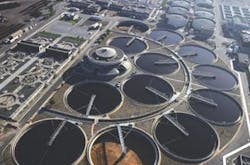Integrated systems help navigate complex water environment
Integrated monitoring and control technologies help municipalities adapt to aging infrastructure, population growth and environmental pressures.
An estimated 1,000+ new water and wastewater treatment facilities need to be built in the United States in order to meet increasing demands from a growing population and to protect the environment. Construction of new plants would increase treatment capacity by more than 5,000 million gallons per day.
US municipalities are also finding it necessary to expend significant resources to rebuild aging infrastructure and modernize existing water and wastewater treatment facilities. The US Environmental Protection Agency’s (EPA) latest Drinking Water Infrastructure Needs Survey and Assessment indicates that the nation’s 53,000 community water systems and 21,400 not-for-profit, non-community water systems will need to invest an estimated US$ 276.8 billion between 2003 and 2023.
Elsewhere, enormous growth and development in regions such as Asia have placed greater demands on water services in major population centers. Consequently, new facilities are being built to keep up with the population surge.
Several factors affecting the industry have implications for the monitoring and control of new and existing treatment facilities.
• Growth in the number and complexity of regulatory and environmental requirements;
• An increased focus on security;
• Staff that is strained by increasing pressure to do more with less, including juggling regulatory demands, protecting publicly-owned assets and being good financial stewards of public dollars; and,
• Newer treatment technologies, in areas such as desalination, which already are common in the Middle East and now are gaining ground in the USA.
In such a demanding environment, the ability to efficiently and expertly manage water treatment processes and systems will play an important role in meeting the needs of communities and populations around the world.
Measurement solutions
Running tests to detect the presence of every conceivable contaminant and agent is difficult. In addition, the number of vulnerable points in any distribution system can be very high. The situation can become even more challenging when resources are limited.
Water treatment plants can reduce the risk that contamination events will be missed by using an online, multi-parameter water quality system that continuously measures several critical water quality variables - such as pH and ORP, conductivity, temperature, free chlorine and monochloramine, oxygen and turbidity - at strategic points in the treatment and distribution system. A change in one of these parameters can signal to the plant operator that a contaminant event has occurred so appropriate action can be taken.
This solution provides constant measurement of water quality and detects deviations in expected values, a critical step toward ensuring safety and quality of water treatment and distribution systems. This kind of monitoring makes up a crucial early warning system that enables plant personnel to quickly take action, thereby safeguarding the well being of the public and the environment.
Leveraging integrated control technologies
Municipalities are turning to increasingly sophisticated, integrated automation, instrumentation and control solutions as they navigate today’s complex water environment. Leveraging integrated control technologies allows municipalities to avoid the substantial disadvantages of relying on disparate islands of automation, disadvantages that include incompatibility among systems, difficulty to maintain aging systems due to the scarcity and/or expense of spare parts, and the inability to expand systems to meet the needs of growing population.
The use of only standalone controls is preventing municipalities from realizing the true potential of their resources and fully protecting public assets. Using a common, integrated control platform makes it possible to operate plants more efficiently, reduce costs, and take advantage of advanced control technology that facilitates the sharing of information throughout the organization. The ability to share information paves the way for easier and more efficient financial, environmental and regulatory reporting, and can even tie multiple plants together.
One of the factors that makes integrated control systems appealing to municipalities of all sizes is the use of widely recognized, commercially available hardware, software, networking and communication interfaces. A major benefit of this open systems approach versus proprietary systems is that it allows organizations to easily and cost-effectively modify, expand or upgrade the system to meet future needs, eliminating concerns about obsolescence.
The integrated control system architecture for water/wastewater industries often incorporates a SCADA (supervisory control and data acquisition) system for wide-area monitoring and control of operations from a single location. These operations may include remote pumping stations, wastewater collection systems, water distribution, PLCs, sewer diversion, water irrigation, wet weather overflow protection and weather monitoring. This integrated architecture ensures that operating parameters are adjusted according to changing situations, thereby helping the plant to run smoothly.
Municipal authorities that are constructing new facilities or upgrading existing operations are discovering that adopting a digital bus-based control architecture takes monitoring and control to a whole new level. A digital plant architecture incorporates high-speed communications networks, intelligent field devices and bus I/O technologies to offer unprecedented insight into operations at a single plant, or across multiple plants within a municipality’s operations.
This insight is further enhanced by incorporating asset management software applications into the control system to ensure critical equipment assets - including mechanical equipment, electrical systems, process equipment, and instruments and valves - are properly operating, thereby helping water and wastewater facilities meet environmental mandates and lower overall operations and maintenance costs.
Furthermore, the network of predictive intelligence that is offered by an integrated monitoring and control system enables municipalities to detect process and equipment problems even before they occur. This abnormal situation prevention makes it possible to be proactive rather than reactive, thereby translating into more efficient deployment of personnel.
Harbin City, China’s seventh-largest city and capital of Heilongjiang Province, provides a good example of a major urban area that adopted a leading edge, integrated monitoring and control system. Harbin City has three million residents and produces 940,000 tons of wastewater per day. The Municipal Authority of Harbin is building a new 450,000-cubic-meters-per-day water treatment plant, a new 356-million-cubic-meters reservoir complex and expanding and rehabilitating its existing water distribution network by installing 175 km of pipeline. This comprehensive project is China’s first integrated water/wastewater project.
At Harbin, the digital automation architecture will consist of a distributed control system, 142 Foundation fieldbus intelligent field devices and a SCADA system with integrated asset management software that will provide continuous monitoring and control of the new plant and reservoir complex, in addition to monitoring and control of 14 existing remote wastewater plants and pump stations that are part of the wastewater collection system.
In total, the control system will monitor and control roughly 20,000 I/O points. The system will provide superior control of processes and opportunities for cost savings. Furthermore, installation of the integrated control system will also enhance operational efficiency and flexibility by enabling operators to monitor both the water and wastewater processes from a single location - a new central control center to be located at the municipal authority’s headquarters.
The Harbin project illustrates the ways in which large organizations are implementing an integrated control approach to fully and efficiently integrate and optimize their assets. The technology can be scaled and customized, so that municipal authorities can realize dramatic benefits whether they serve three million people or 3,000 people.
In the US, the Borough of Ridgway, Pennsylvania, which supplies water to approximately 8,000 people, illustrates this capability. The Borough of Ridgway is experiencing measurable improvements in plant efficiencies since replacing its outdated controls with an integrated SCADA system. For example, the SCADA system improved the sensitive and complex backwashing system, a cyclic process in which filters are periodically washed out to remove sediment. The new control system enables Ridgway to use only 15,000 gallons of water instead of approximately 20,000 gallons previously required, which translates into a 25 percent reduction in water and chemical usage during each backwash process.
Additional efficiencies have been possible because the information from the borough’s SCADA remote terminal unit (RTU) is available to the control system and desktops of Ridgway supervisors and managers. This automation permits faster and more effective decision-making, and also translates into more efficient workforce deployment. Previously, operators spent a total of two hours per day manually checking reservoir water levels. Now they can make better use of their time.
Enhanced reporting is another benefit of the new control system. Prior to installing the new system, important plant data was collected and compiled manually from each separate control system. Now, the integrated control system provides approximately 90 percent of the information required to complete EPA reports.
Conclusion
Integrated monitoring and control systems have been proven to deliver operational flexibility, improved reliability, increased operating efficiencies, the ability to meet operations and maintenance budgets, and maintain environmental and regulatory compliance. The issues facing the water treatment industry will keep evolving, but these systems enable the industry to nimbly respond to changing conditions.
In this environment of competing resources, priorities and pressures, integrated monitoring and control systems can help the water and wastewater industry meet complex operational and financial demands, and protect valuable environmental resources.
Author's Note
Douglas Johnson is the Water Industries’ Development Director of Emerson Process Management Power & Water Solutions, and is based in Pittsburgh, Pennsylvania, USA.
Advanced control software help balance competing concerns
Incorporated into an organization’s integrated control system, advanced control software achieves even greater efficiency and cost savings. Advanced control software incorporates fuzzy logic, neural networks and model-based predictive controls, in addition to other tools developed to meet the needs of water and wastewater industries.
Equipped with this artificial intelligence capability, advanced control software optimizes water treatment and wastewater treatment processes to minimize costs, reduce equipment wear and tear, and balance tradeoffs, such as low and high flow. This solution can be applied to many key areas of operation within the plant and throughout the water system, including chemical usage (modeling chemical usage for acids and bases for process utilization to adjust the pH ensures the most efficient - and therefore cost effective - use of chemicals) and pump optimization (optimizing the timing and location of pump usage reduces equipment wear and tear, and minimizes electricity costs).
The energy management capabilities of advanced control software are especially relevant given the growth of desalination. The increased adoption of this high-energy process is taking place at the same time that municipalities are facing rising energy costs and ever-tightening budgets. Because of these conflicting conditions, the ability for municipalities to manage energy resources is now more important than ever. Advanced control software can help balance these competing concerns so that desalination remains an economically viable process.


